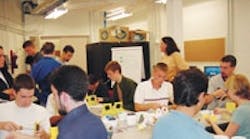On the same day Barack Obama became the 44th president of the United States, Sen. Mark Warner (D-VA) told more than 100 manufacturing representatives attending a National Association of Manufacturers (NAM) Leadership luncheon that the United States needs to "get serious about workforce training" if it's going to be a leader in 21st century innovation, according to NAM.
He stressed the need to align governmental education programs such as Head Start, No Child Left Behind and the Perkins Act to achieve clear policy goals. One educational area that might deserve a closer look is the teaching of lean manufacturing principles at the high school and college level.
Over the years, several universities and vocational programs have implemented lean courses as part of their curriculum. Through its Manufacturing Extension Partnership, Massachusetts has utilized grants to offer lean training at both the college and vocational levels. For instance, the Worcester Polytechnic Institute applied a National Science Foundation grant to develop hands-on lean training through its Department of Management. The curriculum includes a simulation program developed by Time Wise Management Systems in which students assemble clocks using a multistage process, says Kathie Mahoney, strategic partner development manager, Massachusetts Manufacturing Extension Partnership (MassMEP).
"It helps them understand through properly placing workers that they can improve production," Mahoney says. "We teach them how it's the process that makes it confusing, not the people, and if you improve the process and train the people properly, you can produce more."
The simulation is conducted in a group of 15 to 20 people with each person assigned a different role, such as assembler or production supervisor. Each round takes approximately 15 minutes and corresponds to a work shift. As the students progress, they're expected to increase the number of clocks they produce by applying lean principles. A similar program is in place at 19 colleges and universities across the United States, according to Mahoney.
MassMEP had a similar program in place for three years aimed at attracting at-risk youth between the ages of 16 and 22. These students learned basic manufacturing terminology and lean principles through the Time Wise simulations. The program attracted about 100 participants a year. "It gave them another opportunity other than college and showed them how you can use your knowledge in the work environment," Mahoney explains.
The program ended after only three years when funding dried up.
"If the funds become available, we would offer it in the future," Mahoney says.
See Also




